Peak Cavern
Devil’s Arse - Devil’s Hole
Useful Information
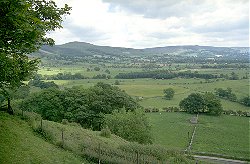
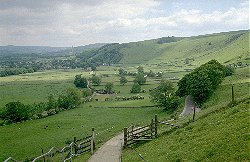
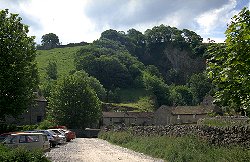
| Location: |
Peak Cavern Road,Castleton, Hope Valley, Derbyshire S33 8WS.
In Castleton, Peak District. Car park at Buxton Road, 10 minutes walk. 25 km from Sheffield, 45 km from Manchester. (53.339765, -1.777823) |
| Open: |
APR to OCT daily 10-17. NOV to MAR Sat, Sun 10-17, daily during school holidays. Tours every hour, last tour 16. Closed 25-DEC, Boxing Day, 01-JAN. [2022] |
| Fee: |
Adults GBP 18, Children (5-15) GBP 11, Children (0-4) free. Online: Adults GBP 17, Children (5-15) GBP 10, Children (0-4) free. Groups (15+): 15% discount. Groups (25+): 20% discount. [2022] |
| Classification: |
 Karst Cave Karst Cave
 river cave. river cave.
|
| Light: |
 Incandescent Incandescent
|
| Dimension: | L=17,750 m, VR=248 m, T=7 °C. |
| Guided tours: | L=800 m, D=60 min. V=120,000/a [2000] |
| Photography: | allowed |
| Accessibility: | yes, with restrictions, call or email for information. |
| Bibliography: |
Stephen Booth (2004):
One Last Breath
Harper Collins Publ. UK, 656 pp. ISBN-10: 0007172044, ISBN-13: 978-0007172047.
Hugh Jarse (2001): Cave Marketing hits rock bottom, Pelobates, Croydon Caving Club Magazine (81) Dec 2001 p7. Brian Woodall (1979): Peak Cavern, 12 pp, illus, survey. SB Contents include: The Approach, The Show Cave, The Far Reaches, Formation, History, Traveller’s Tales and Folklore & Legend. Stephan Kempe, Christhild Ketz-Kempe, Erika Kempe (2009): Early cave visits by women and the travel accounts of Lady Elisabeth Craven to the Grotto of Antiparos (1786) and Johanna Schopenhauer to Peaks Cavern (1803), Conference: 15th International Congress of SpeleologyAt: Kerrville, Texas, USA, July 19-26,2009, Volume: Proceedings: 1993-1999. researchgate Thomas Hobbes (1636): De Mirabilibus Pecci: Being The Wonders of the Peak in Darby-shire, Commonly called The Devil’s Arse of Peak online |
| Address: |
Peak Cavern, Peak Cavern Road,Castleton, Hope Valley, Derbyshire S33 8WS, Tel: +44-1433-620285,
E-mail: |
| As far as we know this information was accurate when it was published (see years in brackets), but may have changed since then. Please check rates and details directly with the companies in question if you need more recent info. |
|
History
| 1803 | Johanna Schopenhauer (*1766-✝1838) first known woman who visited the cave. |
| 1880 | visited by Queen Victoria for a concert, renamed Peak Cavern. |
| 1915 | last inhabitants of the cave leave. |
| 23-MAR-1959 | student Oscar Hackett Neil Moss died in a caving accident. |
| 1989 | The Chronicles of Narnia filmed at the cave by the BBC. |
| 1989 | the Five Arches part of the tour closed to the public. |
| 1996 | connections to Speedwell Cavern and James Hall’s Over Engine Mine discovered. |
| 1999 | Titan Shaft discovered, the deepest drop in Britain (141.5 m). |
| 2013 | number of concerts inside the cave increased. |
| 2013 | used as a cinema during Sheffield Doc/Fest for a screening of The Summit. |
Description
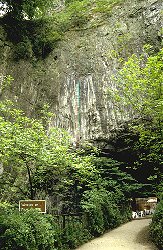
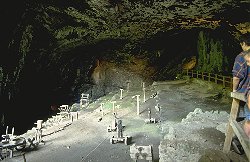
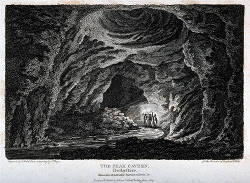
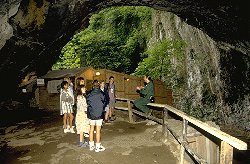
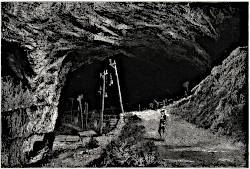
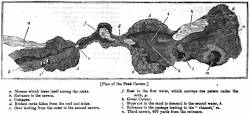
The most impressive sight of Peak Cavern is definitely the entrance portal and the first chamber. A subterranean river called River Styx flows through Peak Cavern and leaves it near Castleton. This river formed the cave, and as the cave grew, the first part of the cave ceiling collapsed. A small gorge was formed, actually a roofless cave, which leads to today’s cave entrance, 20 m wide and 30 m high below a high limestone cliff. It is the largest cave entrance in Britain.
The huge room behind the entrance named The Vestibule is more than 100 m long and was used by the inhabitants of Castleton for several hundred years. The cave is a shelter against rain and was the largest "dry" place on the isles for a very long time. So it was ideal for rope making, the remains of which can still be seen today. There are several plateaus with wooden huts and the remains of wooden ropewalks. Rope is made by twisting fibres together, then the result is again twisted together, several times, depending on the desired thickness. The twist of the strands in a twisted or braided rope keeps a rope together. But the main reason for twisting is to more evenly distribute tension among the individual strands. The high humidity of the cave air was actually helpful in keeping the fibres soft, but there was always the danger of them going moldy.
The locals who made a living from rope making lived in houses built inside the cave mouth until 1915.
They are sometimes dubbed Britain’s last troglodytes, although thats not true, the
 Kinver Edge Rock Houses
near Kidderminster were populated until the 1950s.
There were legends that the depths of the cave were used as a hideout by bandits.
According to legend a meeting between Cock Lorel, leader of the rogues, and Giles Hather, the King of the Gypsies, took place inside the cave around 1530.
On this meeting thieves’ cant was created, a sort of secret language used by thieves to talk to each others and not be understood by normal people.
It is more like a dialekt, and there are harmless words for terms related with illegal activities, for example foin for a pickpocketing technique or fence for a person who buys stolen goods.
It actually seems to have originated in this period, but the story is almost certainly a myth.
The thieves’ cant is today more popular than ever, as it is used in literature and fantasy role-playing.
Kinver Edge Rock Houses
near Kidderminster were populated until the 1950s.
There were legends that the depths of the cave were used as a hideout by bandits.
According to legend a meeting between Cock Lorel, leader of the rogues, and Giles Hather, the King of the Gypsies, took place inside the cave around 1530.
On this meeting thieves’ cant was created, a sort of secret language used by thieves to talk to each others and not be understood by normal people.
It is more like a dialekt, and there are harmless words for terms related with illegal activities, for example foin for a pickpocketing technique or fence for a person who buys stolen goods.
It actually seems to have originated in this period, but the story is almost certainly a myth.
The thieves’ cant is today more popular than ever, as it is used in literature and fantasy role-playing.
Right behind the entrance chamber the cave became not only small, but very low, and it was the bed of the cave river. There was only one way to cross this section, by lying down on a boat. It was widened using explosive, actually the only part of the tour were such massive alterations were necessary at all Today it is called Lumbago Walk, because traversing it still requires most adults to stoop. The tour follows the main passage through two main caverns, The Great Cave and Roger Rain’s House, and into a passage named Pluto’s Dining Room. Here is the end of the tour and the visitors return on the same path. Until 1990 the tour was twice as long, but at this point the trail descends on Devil’s Staircase to Halfway House, where the cave river, called Inner Styx, is met again. Unfortunately this part was flooded frequently in winter, and occasionally in summer. The required regular clearing of debris and mending of the trails and railings was quite expensive, and due to the floods the show cave was closed during winter. The last drop was the radon hysteria of the time, which had a rather high concentration in this lower part. Radon is a harmless noble gas, but it contains radioactive isotopes, and there was the fear, that cave guides which were exposed several hours daily, could get cancer. Actually most underground sites have radon and radiation sensors today, and the time underground is restricted, but it is definitely far less dangerous than they thought back then. Nevertheless, the far end of the tour was closed and since 1997 cave tours are offered all year round. The abandoned part of the cave tour was returned to a more natural state by removing the installation, especially the wooden bridges across the cave river.
...there is a cave or hole within the ground called, saving your reverence, The Devils Arse, that gapeth with a wide mouth and hath in it many turnings and retyring roomes, wherein, for sooth, Gervase of Tilbury, whether for want of knowing the truth, or upon a delight hee had in fabling, hath written that a Shepheard saw a verie wide and large Country with riverets and brookes running here and there through it, and huge pooles of dead and standing waters.
Notwithstanding, by reason of these and such like fables, this Hole is reckoned for one of the wonders of England...
William Camden (1586): Britannia.
The cave was originally named The Devil’s Arse, that’s the name used by William Camden in his book Britannia in 1586. It was also used by Thomas Hobbes in 1636 and by Daniel Defoe in A tour thro’ the whole island of Great Britain (1724–27). When the cave was visited by Queen Victoria for a concert in 1880, it was renamed Peak Cavern in order not to cause offence. It seems this was quite common in Victorian Times and happened several times. The name was changed back in 2006, and visitor numbers have risen 30 %, claims show cave director Jeremy Gosling. Where this name originates is unknown, but people guessed it’s because the noises from inside the cave during floods sound like flatulence. We have not renamed the page, as the cave is better known among cavers under its former name.
When there is no flood and no disturbing noises, the huge chamber is used for concerts. We already mentioned the one in 1880 which was visited by Queen Victoria. Jarvis Cocker, founder and frontman of the band Pulp, Kim Wilde, Richard Hawley and The Vaccines had concerts here. In 2013 during Sheffield Doc/Fest the cave was used as a cinema screening The Summit, a 2012 documentary film about the 2008 K2 disaster, directed by Nick Ryan. It was attended by 500 people. It seems such events are a valuable second income for the operator, and the cave is classed as an Open-Air Venue. There are a dozen concerts planned for 2023. While it is essentially outside the huge cave roof is protecting the attendees from the elements.
The Peak Cavern - Speedwell Cavern Cave System is the 5th longest cave system in England in 2022, with a total length of 17.75 km. Two entrances are actually show caves, the third is through a mine on the moor above. The connections to Speedwell Cavern and James Hall’s Over Engine Mine were discovered in 1996. For cavers the moste noteworthy superlative is actually the Titan Shaft, the highest pitch in Britain, at 141.5 m. It is also spectacular because of its size, being approximately equal in volume to the second-largest chamber in Britain. As there are numerous parts which were created by mining, not all the length and vertical range given are actually natural.
But there is also a tragedy linked to the cave, the so-called Neil Moss tragedy. Oscar Hackett Neil Moss (*28-JUL-1938–✝23-MAR-1959) was undergraduate studying philosophy at Balliol College, Oxford. He was exploring the cave when he got stuck after descending a narrow unexplored shaft. His comrades tried to haul him free, but the rope broke several times. Other cavers tried to get to him but the shaft was really narrow, and only the 18 year old June Bailey even got to him. The main problem was that the shaft was so narrow and thus the ventilation was poor. The CO2 he exhaled forme a lake around him and June Bailey was "driven back by foul air." He finally lost consciousness after one day and was declared dead on the morning of the next day. His father requested that his son’s body be left in place to avoid risk of further injury or loss of life. The fissure was sealed with loose rocks and is now known as Moss Chamber. Like often with such caving accidents it was widely publicised, even in international press, as we have seen again some years ago with the soccer team in Thailand. In 2004 Stephen Booth wrote the novel One Last Breath, his fifth thriller featuring Detectives Fry and Cooper, which was inspired by the cave accident. In 2006 fellow Derbyshire caver Dave Webb produced the documentary Fight For Life – The Neil Moss Story.
In olden days you went there, purchased tickets at the kiosk in the cave portal and waited for the next tour. Those times are definitely over. The operators sold ticket only online during the pandemic, to make sure the number of visitors was limited. Today they still prefer online sales, but if available, unsold online tickets may be purchased at the kiosk 10 minutes before each tour. Please make sure to arrive 10 minutes before the start time, in summer it might be difficult to find a parking lot and there is a 10-minute walk uphill to the cave entrance..
- See also
 Caves With The Tallest Cave Entrance
Caves With The Tallest Cave Entrance Peak Cavern, text from: Tony and Anne Oldham (1972): Discovering Caves - A guide to the Show Caves of Britain.
Peak Cavern, text from: Tony and Anne Oldham (1972): Discovering Caves - A guide to the Show Caves of Britain. Search DuckDuckGo for "Peak Cavern"
Search DuckDuckGo for "Peak Cavern" Google Earth Placemark
Google Earth Placemark Peak Cavern - Wikipedia (visited: 16-OCT-2022)
Peak Cavern - Wikipedia (visited: 16-OCT-2022) The Neil Moss tragedy - Wikipedia (visited: 16-OCT-2022)
The Neil Moss tragedy - Wikipedia (visited: 16-OCT-2022) Peak Cavern "The Devil’s Arse!", official website (visited: 16-OCT-2022)
Peak Cavern "The Devil’s Arse!", official website (visited: 16-OCT-2022)
 Index
Index Topics
Topics Hierarchical
Hierarchical Countries
Countries Maps
Maps